The Risky Old School Method For Canning Fried Chicken
For people with gardens, home canning can be a great way to ensure all their hard work doesn't go to waste and their fresh, home-grown fruits and vegetables can last all year. Although canning is a potentially dangerous process and needs to be done carefully to avoid the possibility of illness, most people don't struggle with canning produce. Meat, on the other hand, is a far riskier endeavor for home canning. This is because meat is naturally low in acidity. When canning, an important step is to heat up the food either in a hot water bath or a pressure canner to kill off any bacteria, particularly the bacteria which causes botulism, per the CDC.
As Simply Canning explains, the bacteria which causes botulism is on lots of foods because it can be found in dirt, though it is not dangerous until the spores start to multiply and die off, creating a potentially lethal toxin. These spores thrive in low-oxygen, low-acid environments, which is why foods with a lower acidity need to be cooked at a higher temperature and higher pressure to ensure any potential botulism spores are eradicated. As The Prairie Homestead notes, if you are going to attempt to can your own meat, you absolutely must do it with a pressure canner in order to avoid the risk of becoming sick.
A dangerous old method
With all the precautions that we now recognize must be taken to safely preserve meats at home, it is truly shocking to see cooking tips from the past which treat the process with so little caution. As noted by Southern Living, the "Blue Book of Canning and Preserving," released by prominent canning brand Ball since 1915, has some entries from decades past have aged as badly as poorly preserved food, including an issue from the 1920s that recommended preserving entire fried chickens.
According to the recipe, home cooks should fry the chicken "as though for serving directly on the table" (via Iowa University Libraries) and cook it about 75% of the way before rolling the entire chicken in half and tying it with twine, then dropping the partially fried bird into a sterilized jar before filling it with liquid from the pan.
Obviously, this is a terrible idea. Even among people who can meat, canning poultry is less common because of its risk for foodborne illness. The Prairie Homestead, for instance, does not discuss preserving poultry; rather, the site lists steps for canning venison, beef, pork, or elk. Meanwhile, the USDA's canning guide recommends boiling, steaming, or baking chicken if preserving it cooked — never frying.
With some of the questionable methods of food preparation our ancestors used as recently as last century, it's a wonder many of us are alive today to look back and shake our heads in disbelief.

